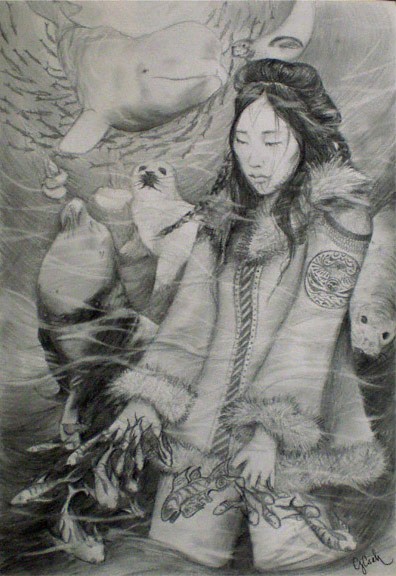
Sedna, Inuit divinity of fate and the seas
Next Post: Gnawa Stream V
It is a fact many belief systems have non-straight spiritual beings.
Worldwide, the number may reach beyond a hundred.
We cannot link identities such as LGBTQ to them per se,
as they predate modern expression.
But for clearer reading, LGBTQ (lesbian, gay, bisexual, trans, etc,) will be used.
You need a decolonial lens to see.

Sedna, Inuit divinity of fate and the seas
Indigenous ancestors and spirits affect not only agriculture, love and natural cycles.
They also connect with the summoner via ancestral magic, power.
And their genders, very forms can change.
In this way, ancient bonds between humans reflected sexual openness and strength.
Supernatural and human gender fluidity are timeless.
Androgynous, trans-, same-sex oriented and genderfluid
identities exist in African belief systems.
Dahomey cosmology, or Vodun, centers around
Mawu-Lisa as the second heavenly Creator.
They are made from the sun and moon as one.
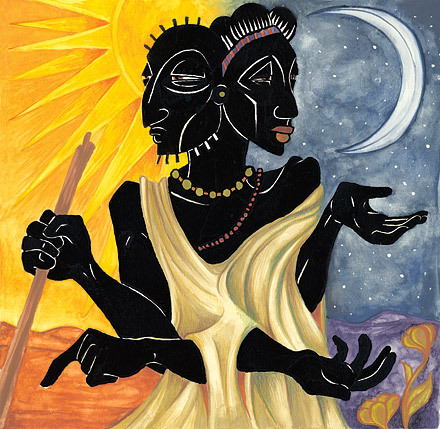
Lisa engaged Mawu in physical union when sun eclipsed moon.
And this creator-duo arc exists with Obatala and Oduduwa in Yoruba too...
two divine beings, different genders, united as one to make the world.
Mawu-Lisa's Great Mother, Nana-Buluku, is this universe's architect.
She too has genderfluid attributes without limitation.
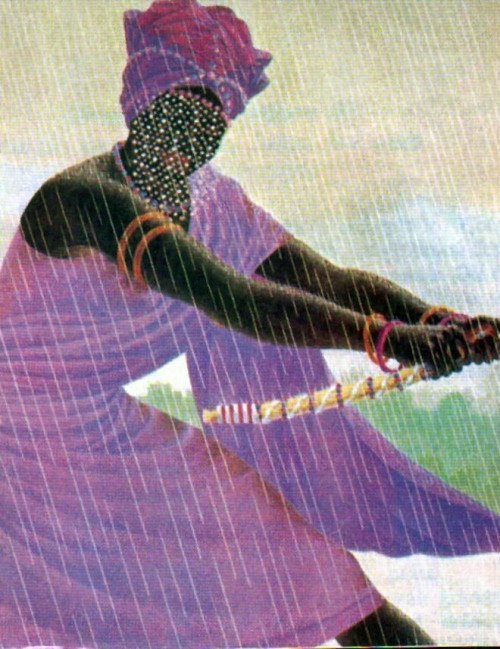
Nana-Buluku is a supreme divinity for several Central-West African ethnic groups.
Matrilineal Akan peoples through Gabon,
Ghana and Guinea,
Togolese Ewe, Nigerian Igbo and Yoruba communities
consider Nana-Buluku "the great supporter of the world".
Their role and worship vary regionally, but Nana-Buluku
has always represented primordial power at Earth's beginning.
Africa would be a different continent without this history.
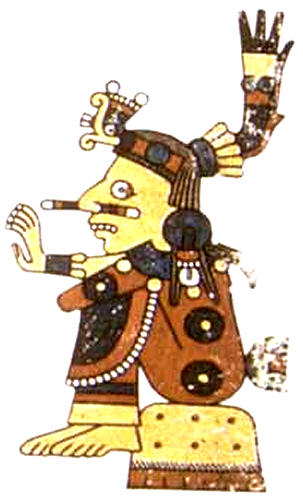
The Aztec "flower-prince" Xochipilli [said as sho-ki-PEEL-i)
Xochipilli (Toltec + Aztec) is guardian saint of same-sex love
(in addition to the fine arts, springtime and games).
He also watches over genderfluid, queer sex workers and worshippers dutifully.
Xochiquetzal (Xochipilli's female counterpart) and Tlazoteotl
protect patlache, a Nahuatl word for women-loving women.
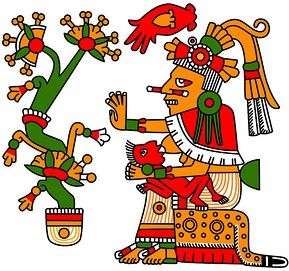
Xochiquetzal, Aztec entity of childbirth, fertility, love and sexual power
Similarly, the Aztec lunar divinity Coyolxauhqui is
interpreted as a patlache.
Chicana artists have reenvisioned her
with themes of non-heterosexuality.
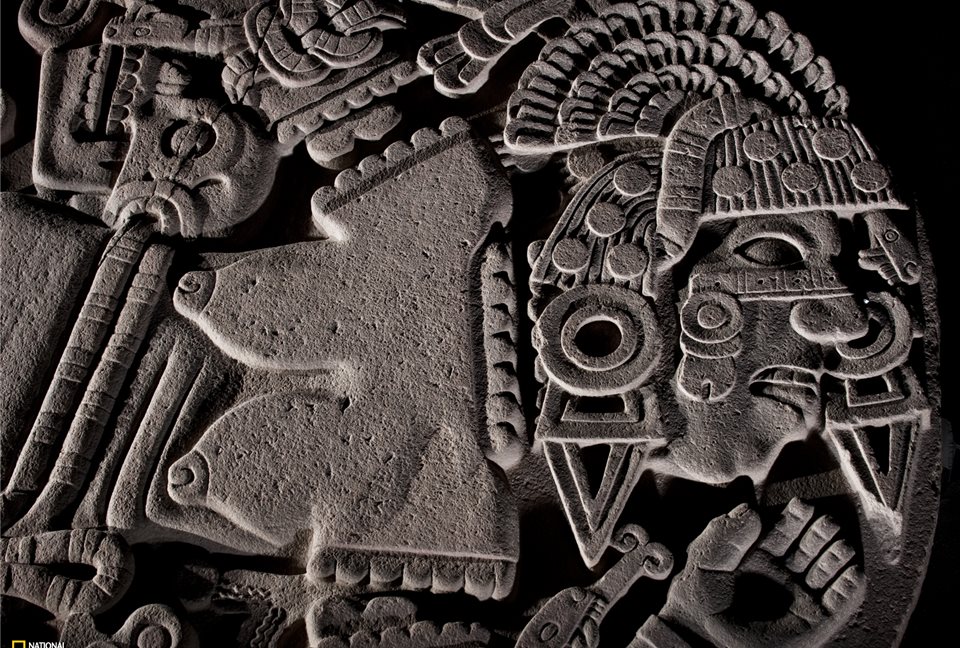
Xmucane and Xpiacoc were ancient deities who created the world
as a pair: divine grandparents of the Maya
(Encyclopedia of Lesbian and Gay Histories).

Haitian Vodou has Erzulie Dantor, the iwa of queer femmes and more.
Inle, Erinle, is their beloved equivalent in Cuban santeria.
Baron Samedi is a very interesting loa in the Caribbean.
Chronology of Mexican Gay History
Tu'er Shen ("rabbit deity" [兔兒神]) is a Chinese lord-god
and conduit of gay romance.
The Tale of the Rabbit God arose from
Zi Bu Yu (子不语),
Qing poet Yuan Mei's supernatural anthology.
The translation vaguely means "what Confucius did not speak of".
Yuan remains a profound writer today. Why the rabbit?
This connotation carried
derogatory undertones for
homosexual people
(Huffington Post). Same-sex discrimination had its supporters
among imperial China's highest government.
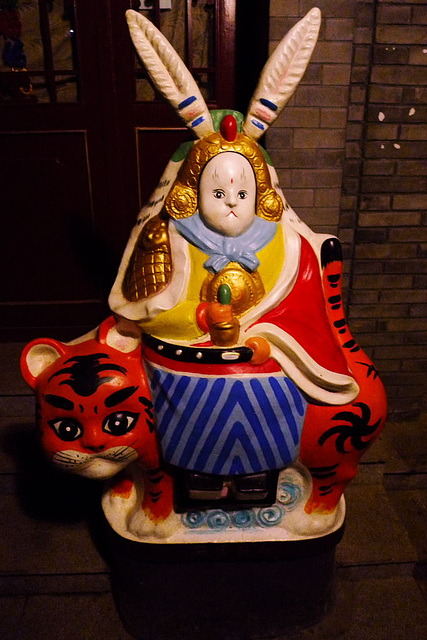
This legend paints a prophetic portrait for gay men.
Hu
Tianbao had been human once,
afraid that his feelings risked discovery from a fellow official.
Hu's stare and confession earned him a fatal beating.
Yang Wang (underworld's god) passed judgment
on Hu's death and ruled that it had been unfair.
Newly reincarnated Tu'er Shen appeared in a
fellow
villager's dream one month later.
His love earned respect from the townspeople
to the gods.
The Rabbit God's temple was called "Tu'er shen
miao" (Ming and Qing Homoerotic Tales (English download).
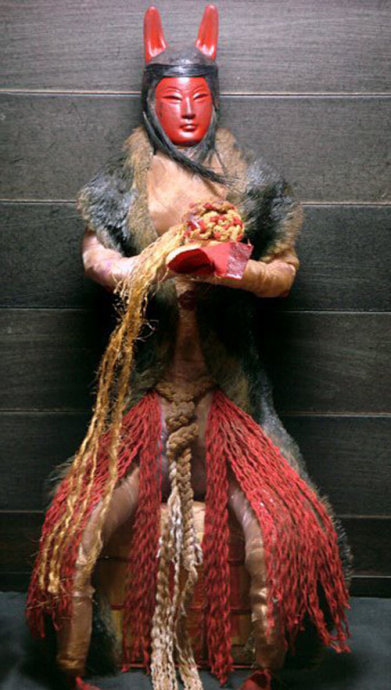
Yuan Mei's Rabbit God is not widespread beyond Fujian
(southern China) and Taiwan, so scholars wonder if they
were an artistic invention with real-life parallels.
Qing court records hold that Hu
Tianbao sects did exist!
We're still unsure on many inner details.
Homophobic government tried to stamp their
existence out with resounding success.
The question confounds. Tu'er Shen—an
actual deity or
written myth?
Did Yuan find an ancient cult and preserve their
story,
or were they perpetuating Yuan's? We'll never be sure...
A Tu'er Shen temple opened in 2006 for Taiwan's capital, Taipei: Wei-ming.
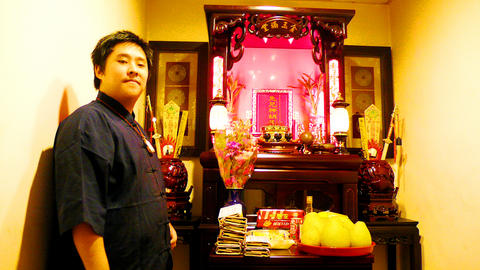
Lu Wei-ming at the Shrine of the Rabbit God
Taoist priest Lu Wei-ming understood members of
the gay community needed spiritual affirmation.
LGBTQ protection from religious persecution is sought here.
"Religions both in the West and the East have long
pushed the homosexual community into the margin.
But providence is benign, and love is given to
all human beings as equals." (Taipei Times)
This benevolence is found in Tu'er Shen.
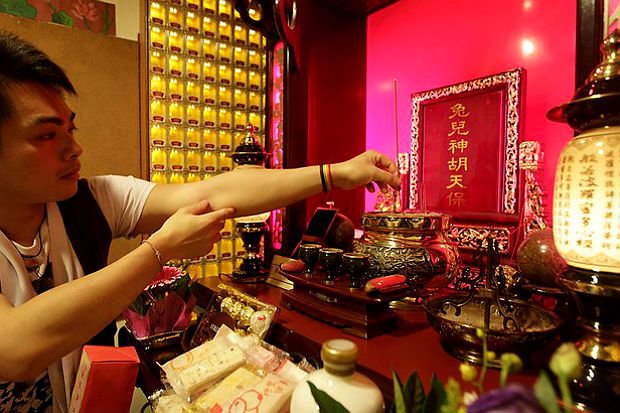
A visitor lighting an offering of incense for Ta Yeh (master, 大爺)
Gay pilgrims visit Wei-ming temple from the world
over: 9,000 or so a year (Huffington Post)
Kali, Krishna and Shiva are all Hindu 'third sex' deities at some point or another.
They have all had reincarnations of genders beyond their "born" one.
Enki the Wise molded the Assyrian half-god
Asushunamir, Inanna's savior from the underworld.
Asushunamir are neither femme or male.
They are gender-variant, and in possession of
pure, spiritual light-"Their rise is brilliant".
Imagine that interpretation of trans identity instead, a shining star.
Transgenderism and Same-Sex Love and Lust in
Chinese Tales of the Supernatural
and Strange
All-father Odin maintains a gender-crossing role throughout Viking folklore.
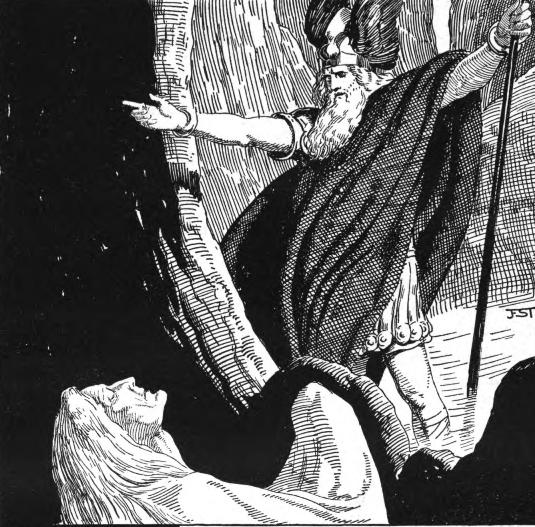
He acknowledged women as spirit masters via emulation (Odin
and Women's Wisdom).
Odin wore women's clothing during his travels and
prophecies
(Engendering Performance in the Late Iron Age).
This aligns with Viking artifacts.
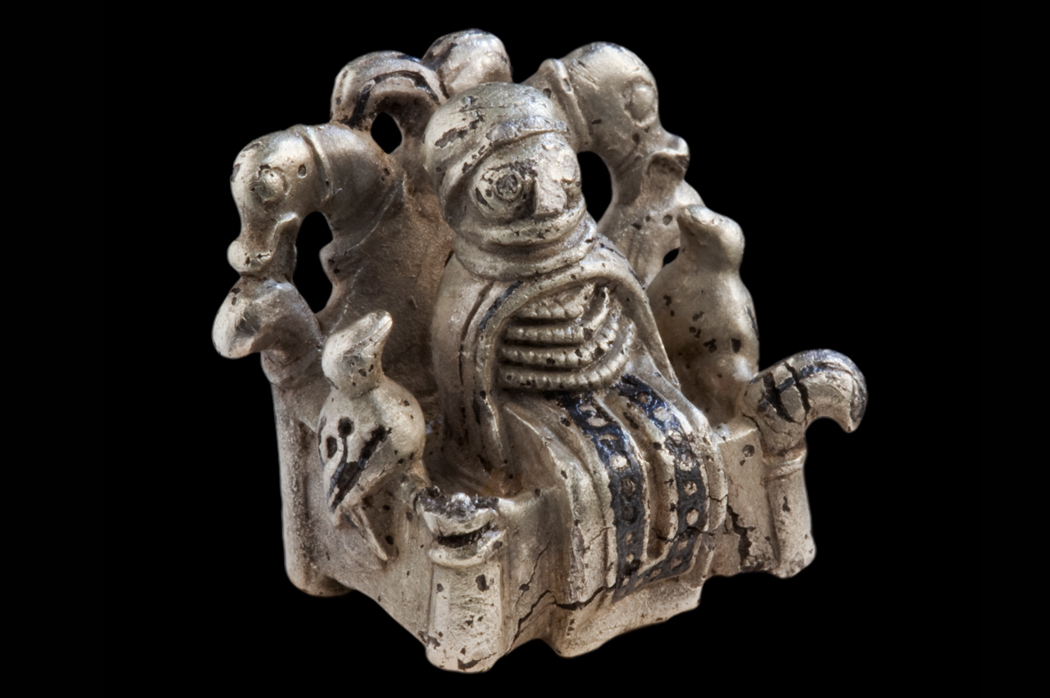
Odin from Lejre, 900 A.D. Roskilde Museum, Denmark.
Odin rests on his cosmic "seat" Hliðskjálf.
Two wolves Freki and Geri flank him.
Both ravens Hugin and Munin sit on each throne arm.
A heavily debated aspect is this figurine's identity.
Are they Frigga who rules in Odin's absence?
Or is
this the All-father in a gender-transient state? (Viking
Rune)
This silver artifact may represent Odin in
Nordic aristocratic woman's dress and
a völva's shawl.
He did convene with
Freyja's oracles enough to emulate them.
In Elder Edda's poem 'Völuspá', a seeress tells Odin
in disguise about Earth's creation and Ragnarok: its end.
Odin practiced Seiðr and galðr, Old Norse words for sorcery
and soul-travelling to other realms (Seeresses of the Viking Period).
These became associated with feminine magic, especially to Vikings
since the goddess-witch Freyja taught Odin
(Homosexuality
and Gender-Bending in the Viking Age).
The ritual of Seiðr
meant that a sorceror/ess
commanded spirits from any gender or sex.
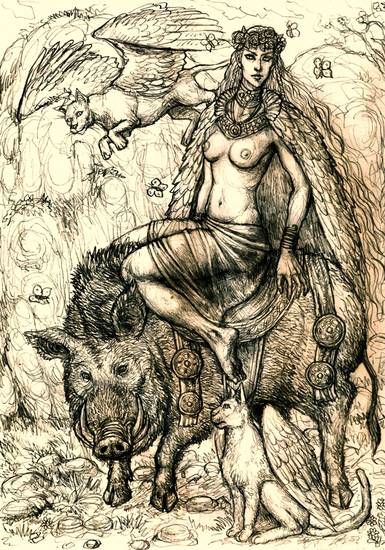
Loki referred to Odin as ergi, an effeminate homosexual
(Nð, Ergi and Old Norse Attitudes),
but we cannot be definite on this widespread opinion.
Norse legend is rife with it. Loki participated in
acts that classify as ergi himself (Sacred Gender
Variance in Ancient Germanic Cultures)
Christian priest Snorri Sturlusson echoed these thoughts in his epic, Heimskringla.
"The use of this magic is accompanied by so
great a
degree of effemination (ergi)...
so that it was taught to the priestesses
(gydjunum)."
(Ynglinga Saga: 7) Such was the stigma.
Sturlusson was certainly part of Danish Christianization,
but nonetheless
expresses a sentiment
in medieval Scandinavia that same-sex male relations
were only shameful if recipients of sexual acts. It's still a mentality.
Gender roles became further entrenched after religious assimilation,
which brutally uprooted shamanistic, non-gender binary sources
of spiritual power (The Construction of Homosexuality).
But the myths still persist. It could be that sexual rites follow shamanic ceremonies.
Loki, the Nordic chief god Odin, and many more deities' chosen orientations are a mystery.
Classical Greek mythology held varied gender roles
and sexual identities from their origin point.
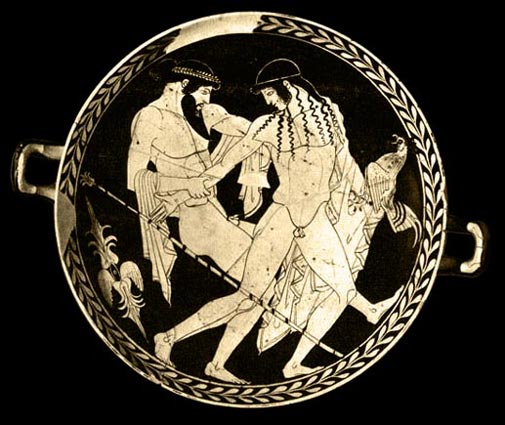
Zeus expresses desire for Ganymede. Kylix (drinking
cup) ca. 450 BCE, Penthesileia
Ganymede returned the god's his scepter and bolt...with interest, we will say.
Greek sun god Apollo frequently met with Hyacinthus, the epic hero, as a lover.

Artemis is a huntress-goddess who rejected male company, and she expected accompanying nymphs to do the same.
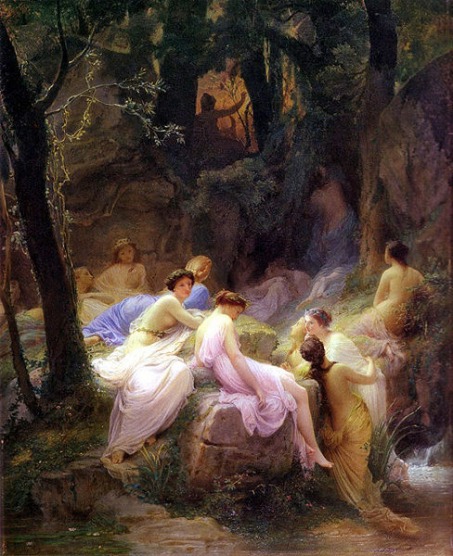
Artemis and the dryad (tree) nymphs
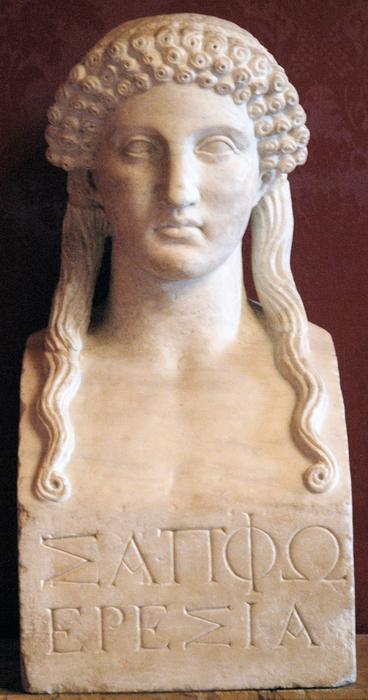
Sappho especially worshipped Aphrodite as a lesbian poet,
because she was guardian over women's passion for one another.
Signals of Belief in Early England: Anglo-Saxon
Paganism Revisited (Alex Sanmark, 2011)
Cassell's Encyclopedia of Queer Myth, Symbol and Spirit (Randy Conner, David Sparks)
Encyclopedia of Queer Myth, Symbol and Spirit Database
A Goddess' History of the World
The Construction of Homosexuality (David Greenberg, University of Chicago Press. 1990)
Trans Expression in Ancient Times (LGBTQ Nation)